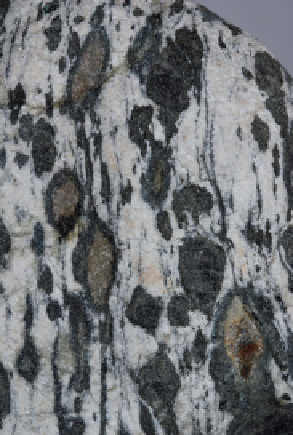Geoscience Reference
In-Depth Information
Syntectonic mineral growth in pressure shadows, fringes or
pull-aparts may also give valuable information on P and T
conditions during a certain tectonic event.
One indication of high strain in metamorphic rocks is the
development of augen, where rigid clasts or grains have
streaked-out tails of recrystallized mineral at either end.
Generally, the tails are composed of fi ner grains of the same
mineral, which suggests that the mineral was metamorphically
stable under the conditions of shearing. In some cases the augen
core reacts to form a new mineral, implying that the augen core
mineral was unstable during shearing. The new mineral formed
from the augen may provide clues to the changed P and T
conditions at the time of deformation (Figure 9.11).
Px
9
9.4.3 Post-kinematic features
Amph
Post-kinematic features generally show random orientation,
indicating static, post-kinematic development. Undeformed
coronas and reaction zones (Section 9.2.3) are a common
example, as are pseudomorphs where the replacement mineral
grains are randomly orientated (decussate). However, the most
conspicuous example of post-kinematic metamorphism is
where randomly orientated porphyroblasts overgrow an earlier
fabric (Figure 9.1, p. 193). This is a common feature of contact
metamorphic rocks (Figure 9.8h). Worked Example 9.2 shows
how diverse observations can be used to reconstruct a
metamorphic history.
Figure 9.11
Augen of pyroxene
in metagabbro, with rims and tails
of amphibole drawn out into the
strong foliation. View about 12 cm
across.
Worked Example 9.2 Charting the exhumation of subducted oceanic crust
In the heart of the western Alps, near Zermatt,
Switzerland a suite of metamorphosed mafi c
rocks has been studied by several researchers.
The rocks have been interpreted to be a
deformed portion of oceanic crust (an ophiolite),
using fi eld evidence such as the features shown
in Figure 9.12, p. 204.
p. 204). The formation of eclogite facies
assemblages seems to have been promoted by the
presence of fl uid during metamorphism,
implying that the transition half-way across
Figure 9.12b represents a fl uid front. In some
weakly deformed metagabbro samples (Figure
9.13b), the foliation is defi ned by blue amphibole
(glaucophane), formed at lower pressures in the
blueschist facies fi eld as the ophiolite was
exhumed towards the surface; in this case
deformation aided metamorphic recrystallization.
Different rocks within the ophiolite responded in
contrasting ways to deformation during the
continental collision that formed the Alps. Many
gabbro bodies were scarcely deformed except
near their margins, and some samples preserve
the original igneous mineralogy and texture
(Figure 9.12b). Other metagabbros also appear
undeformed, but have recrystallized completely
to mineral assemblages indicative of eclogite
facies conditions, at depths implying they were
metamorphosed during subduction (Figure 9.13a,
Weaker metabasalts in the same area are
generally more strongly deformed, either under
blueschist facies conditions, or at even lower
pressures and temperatures nearer the Earth's
surface, in the greenschist fi eld. These retrograde
rocks are dominated by a strong foliation defi ned
by green amphiboles, epidote and chlorite.










